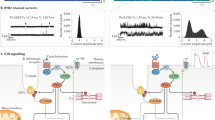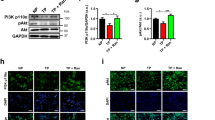Abstract
A reduction in l-type Ca2+ current (I Ca,L) contributes to electrical remodeling in chronic atrial fibrillation (AF). Whether the decrease in I Ca,L is solely due to a reduction in channel proteins remains controversial. Protein tyrosine kinases (PTK) have been described as potent modulators of I Ca,L in cardiomyocytes. We studied α1C l-type Ca2+ channel subunit expression and the regulation of I Ca,L by PTK in chronic AF using PTK inhibitors: genistein, a nonselective inhibitor of PTK, and 4-amino-5-(4-methylphenyl)-7-(t-butyl)pyrazolo-3,4-d-pyrimidine (PP1), a selective inhibitor of src kinases. Furthermore, type-1 and type-2A protein phosphatase activity was measured with phosphorylase as substrate in whole-cell lysates derived from atrial tissue of AF patients. Right atrial appendages were obtained from patients undergoing open-heart surgery. Protein levels of α1C l-type Ca2+ channel subunit were determined using Western blot analysis and normalized to the protein amounts of calsequestrin as internal control. The protein concentrations of α1C did not differ between AF and sinus rhythm (SR; α1C/calsequestrin: 1.0 ± 0.1 and 1.2 ± 0.2, respectively, n = 8 patients). In cardiomyocytes from patients in SR (n = 20 patients), genistein and PP1 both evoked similar increases in I Ca,L from 3.0 ± 0.3 to 6.1 ± 0.8 pA/pF and from 2.8 ± 0.4 to 6.1 ± 0.6 pA/pF, respectively. In cells from AF patients (n = 10 patients), basal I Ca,L was significantly lower. In this case, genistein lead to the same relative increase in I Ca,L as in SR cells (from 1.46 ± 0.30 to 3.2 ± 1.0 pA/pF), whereas no increase was elicited by PP1 suggesting impaired regulation of I Ca,L by src kinases in AF. Total and type 1 and type 2A-related phosphatase activities were higher in tissue from patients with chronic AF compared to SR (4.8 ± 0.4, 2.1 ± 0.2, and 2.7 ± 0.4 nmol/mg/min and 3.6 ± 0.4, 1.3 ± 0.2, and 2.4 ± 0.3 nmol/mg/min, respectively, n = 7 patients per group). Downregulation of I Ca,L in AF is not due to a reduction in l-type Ca2+ channel protein expression. Indirect evidence for an impaired src kinase regulation of I Ca,L together with an increased phosphatase activity suggests that a complex alteration in the kinase/phosphatase balance leads to I Ca,L dysregulation in chronic AF.





Similar content being viewed by others
References
Aiello EA, Cingolani HE (2001) Angiotensin II stimulates cardiac L-type Ca2+ current by a Ca2+ and protein kinase C-dependent mechanism. Am J Physiol Heart Circ Physiol 280:H1528–H1536
Belevych AE, Nulton-Persson A, Sims C, Harvey RD (2001) Role of tyrosine kinase activity in alpha-adrenergic inhibition of the beta-adrenergically regulated L-type Ca(2+) current in guinea-pig ventricular myocytes. J Physiol 537:779–792
Boixel C, Tessier S, Pansard Y, Lang-Lazdunski L, Mercadier JJ, Hatem SN (2000) Tyrosine kinase and protein kinase C regulate L-type Ca2+ current cooperatively in human atrial myocytes. Am J Physiol Heart Circ Physiol 278:H670–H676
Boknik P, Fockenbrock M, Herzig S, Knapp J, Linck B, Luss H, Muller FU, Muller T, Schmitz W, Neumann J (2000) Protein phosphatase activity is increased in a at model of long term beta-adrenergic stimulation. Naunyn-Schmiedeberg’s Arch Pharmacol 362:222–231
Bosch RF, Zeng X, Grammer JB, Popvic K, Mewis C, Kuhlkamp V (1999) Ionic mechanisms of electrical remodeling in human atrial fibrillation. Cardiovasc Res 44:121–131
Brundel BJ, Van Gelder IC, Henning RH, Tuinenburg AE, Deelman LE, Tieleman RG, Grandjean JG, Van Gilst Wh, Crijns HJ (1999) Gene expression of proteins influencing the calcium homeostasis in patients with persistent and paroxysmal atrial fibrillation. Cardiovasc Res 42:443–454
Brundel BJ, Van Gelder IC, Henning RH, Tieleman RG, Tuinenburg AE, Wietses M, Grandjean JG, Van Gilst WH, Crijns HJ (2001) Ion channel remodeling is related to intraoperative atrial effective refractory periods in patients with paroxysmal and persistent atrial fibrillation. Circulation 103:684–690
Christ T, Boknik P, Wohrl S, Wettwer E, Graf EM, Bosch RF, Knaut M, Schmitz W, Ravens U, Dobrev D (2004) L-type Ca2+ current downregulation in chronic human atrial fibrillation is associated with increased activity of protein phosphatases. Circulation 110:2651–2657
Dubuis E, Rockliffe N, Hussain M, Boyett M, Wray D, Gawler D (2006) Evidence for multiple Src binding sites on the α1C L-type Ca2+ channel and their roles in activity regulation. Cardiovasc Res 69:391–401
El-Armouche A, Boknik P, Eschenhagen T, Carrier L, Knaut M, Ravens U, Dobrev D (2006) Molecular determinants of altered Ca2+ handling in human chronic atrial fibrillation. Circulation 114:670–680
Gao T, Cuadra AE, Ma H, Bunemann M, Gerhardstein BL, Cheng T, Eick RT, Hosey MM (2001) C-terminal fragments of the alpha 1C (CaV1.2) subunit associate with and regulate L-type calcium channels containing C-terminal-truncated alpha 1C subunits. J Biol Chem 276(24):21089–21097
Gaspo R, Sun H, Fareh S, Levi M, Yue L, Allen BG, Hebert TE, Nattel S (1999) Dihydropyridine and beta adrenergic receptor binding in dogs with tachycardia-induced atrial fibrillation. Cardiovasc Res 42:434–442
Goette A, Arndt M, Rocken C, Spiess A, Staack T, Geller JC, Huth C, Ansorge S, Klein HU, Lendeckel U (2000a) Regulation of angiotensin II receptor subtypes during atrial fibrillation in humans. Circulation 13:2678–2681
Goette A, Staack T, Röcken C, Arndt M, Geller JC, Huth C, Ansorge S, Klein HU, Lendeckel U (2000b) Increased expression of extracellular signal-regulated kinase and angiotensin-converting enzyme in human atria during atrial fibrillation. J Am Coll Cardiol 35:1669–1677
Grammer JB, Zeng X, Bosch RF, Kuhlkamp V (2001) Atrial L-type Ca2+ channel, beta-adrenoceptor, and 5-hydroxytryptamine type 4 receptor mRNAs in human atrial fibrillation. Basic Res Cardiol 96:82–90
Hanke JH, Gardner JP, Dow RL, Changelian PS, Brissette WH, Weringer EJ, Pollok BA, Connelly PA (1996) Discovery of a novel, potent, and Src family-selective tyrosine kinase inhibitor. Study of Lck- and FynT-dependent T cell activation. J Biol Chem 271:695–701
Hatem SN, Benardeau A, Rucker-Martin C, Le Grand B, Mace L, Dervanian P, Mercadier JJ, Coraboeuf E (1996) Differential regulation of voltage-activated potassium currents in cultured human atrial myocytes. Am J Physiol 271:H1609–H1619
Ichiyanagi O, Ishii K, Endoh M (2002) Angiotensin II increases L-type Ca2+ current in gramicidin D-perforated adult rabbit ventricular myocytes: comparison with conventional patch-clamp method. Pflugers Arch 43:179–189
Ingebritsen TS, Stewart AA, Cohen P (1983) Protein phosphatases involved in cellular regulation. Measurement of type-1 and type-2 protein phosphatases in extracts of mammalian tissue; an assessment of their physiological roles. Eur J Biochem 132:297–307
Kamp TJ (2003) L-type Ca2+ channels in atrial fibrillation: wallflowers or a vanishing act. J Mol Cell Cardiol 35:427–431
Katsube Y, Yokoshiki H, Nguyen L, Yamamoto M, Sperelakis N (1998) Inhibition of Ca2+ current in neonatal and adult rat ventricular myocytes by the tyrosine kinase inhibitor, genistein. Eur J Pharmacol 345:309–314
Klein G, Schroeder F, Vogler D, Schaefer A, Haverich A, Schieffer B, Korte T, Drexler H (2003) Increased open probability of single cardiac L-type calcium channels in patients with chronic atrial fibrillation: role of phosphatase 2A. Cardiovasc Res 59:37–45
Lai LP, Su MJ, Lin JL, Lin FY, Tsai CH, Chen YS, Huang SK, Tseng YZ, Lien WP (1999) Down-regulation of L-type calcium channel and sarcoplasmic reticular Ca2+-ATPase in human atrial fibrillation without significant change in the mRNA of ryanodine receptor, calsequestrin and phospholamban: an insight into the mechanism of atrial electrical remodelling. J Am Coll Cardiol 33:1231–1237
Mehta PK, Griendling KK (2007) Angiotensin II cell signaling: physiological and pathological effects in the cardiovascular system. Am J Physiol 292:C82–C97
Morillo CA, Klein GJ, Jones DL, Guiraudon CM (1995) Chronic rapid atrial pacing. Structural, functional, and electrophysiological characteristics of a new model of sustained atrial fibrillation. Circulation 91:1588–1595
Ogura T, Shuba LM, McDonald TF (2000) L-type Ca2+ current in guinea pig ventricular myocytes treated with modulators of tyrosine phosphorylation. Am J Physiol 278:H670–H676
Ono K, Fozzard HA (1993) Two phosphatase sites on the Ca2+ channel affecting different kinetic functions. J Physiol 470:73–84
Popov N, Schmitt M, Schulzeck S, Matthies N (1975) Reliable micromethod for determination of the protein content in tissue homogenates. Acta Biol Med Ger 34(9):1441–1446
Robinson DR, Wu YM, Lin SF (2000) The protein tyrosine kinase family of the human genome. Oncogene 19:5548–5557
Roskoski R (2005) Src kinase regulation by phosphorylation and dephosphorylation. Biochem Biophys Res Commun 331:1–14
Sayeski PP, Ali MS, Harp JB, Marrero MB, Bernstein KE (1998) Phosphorylation of p130 Cas by angiotensin II is dependent on c-src, intracellular Ca2+, and protein kinase C. Circ Res 82:1279–1288
Schotten U, Ausma J, Stellbrink C, Sabatschus I, Vogel M, Frechen D, Schoendube F, Hanrath P, Allessie MA (2001) Cellular mechanisms of depressed atrial contractility in patients with chronic atrial fibrillation. Circulation 103:691–698
Schotten U, Greiser M, Benke D, Buerkel K, Ehrenteid B, Stellbrink C, Vazquez-Jimenezet JF, Schoendube F, Hanrath P, Allessie M (2002) Atrial fibrillation-induced atrial contractile dysfunction: a tachycardiomyopathy of a different sort. Cardiovasc Res 53:192–201
Schotten U, Haase H, Frechen D, Greiser M, Stellbrink C, Vazquez-Jimenez JF, Morano I, Allessie MA, Hanrath P (2003) The L-type Ca2+—channel subunits α1C and β2 are not downregulated in atrial myocardium of patients with chronic atrial fibrillation. J Mol Cell Cardiol 35:437–443
Schroder F, Klein G, Frank T, Bastein M, Indris S, Karck M, Drexler H, Wollert KC (2004) Src family tyrosine kinases inhibit single L-type: Ca2+ channel activity in human atrial myocytes. J Mol Cell Cardiol 37:735–745
Skasa M, Jüngling E, Picht E, Schondube F, Luckhoff A (2001) L-type calcium currents in atrial myocytes from patients with persistent and non-persistent atrial fibrillation. Basic Res Cardiol 96:151–159
Tessier S, Karczewski P, Krause EG, Pansard Y, Acar C, Lang-Lazdunski M, Mercadier JJ, Hatem SN (1999) Regulation of the transient outward K(+) current by Ca(2+)/calmodulin-dependent protein kinases II in human atrial myocytes. Circ Res 85:810–819
Van der Heyden MAG, Wijnhoven TJM, Opthof T (2005) Molecular aspects of adrenergic modulation of cardiac L-type Ca2+ channels. Cardiovasc Res 65:28–39
Van Gelder IC, Brundel BJ, Henning RH, Tuinenburg AE, Tieleman RG, Deelman L, Grandjean JG, De Kam PJ, Van Gilst WH, Crijns HJ (1999) Alterations in gene expression of proteins involved in the calcium handling in patients with atrial fibrillation. J Cardiovasc Electrophysiol 10:552–560
Van Wagoner DR, Pond AL, Lamorgese M, Rossie SS, McCarthy PM, Nerbonne JM (1999) Atrial L-type Ca2+ currents and human atrial fibrillation. Circ Res 85:428–436
Wang YG, Lipsius SL (1998) Genistein elicits biphasic effects on L-type calcium current in feline atrial myocytes. Am J Physiol 275:H204–H212
Wiechen K, Yue DT, Herzig S (1995) Two distinct functional effects of protein phosphatase inhibitors on guinea-pig cardiac L-type Ca2+ channels. J Physiol 484:583–592
Wijffels MC, Kirchhof CJ, Dorland R, Allessie MA (1995) Atrial fibrillation begets atrial fibrillation. A study in awake chronically instrumented goats. Circulation 92:1954–1968
Yokoshiki H, Sumii K, Sperelakis N (1996) Inhibition of L-type Ca2+ current in rat ventricular cells by the tyrosine kinase inhibitor, genistein and its inactive analog, daidzein. J Mol Cell Cardiol 28:807–814
Yokoyama N, Miller WT (2001) Inhibition of Src by direct interaction with protein phosphatase 2A. FEBS Lett 505:460–464
Yue L, Feng J, Gaspo R, Li GR, Wang Z, Nattel S (1997) Ionic remodeling underlying action potential changes in a canine model of atrial fibrillation. Circ Res 81:512–525
Yue L, Melnyk P, Gaspo R, Wang Z, Nattel S (1999) Molecular mechanisms underlying ionic remodeling in a dog model of atrial fibrillation. Circ Res 84:776–784
Acknowledgments
These studies were supported by the German Federal Ministry of Education and Research (BMBF) through the Atrial Fibrillation Competence NETwork (AFNET, projects C4 and C5 to DD and US, respectively; grant 01Gi0204) and the Dutch Heart Foundation (grant 2002 B040 to US). The authors thank Manja Schöne and Annett Opitz for excellent technical assistance.
Author information
Authors and Affiliations
Corresponding author
Rights and permissions
About this article
Cite this article
Greiser, M., Halaszovich, C.R., Frechen, D. et al. Pharmacological evidence for altered src kinase regulation of I Ca,L in patients with chronic atrial fibrillation. Naunyn-Schmied Arch Pharmacol 375, 383–392 (2007). https://doi.org/10.1007/s00210-007-0174-6
Received:
Accepted:
Published:
Issue Date:
DOI: https://doi.org/10.1007/s00210-007-0174-6




